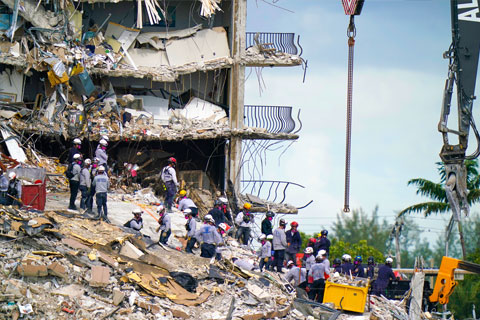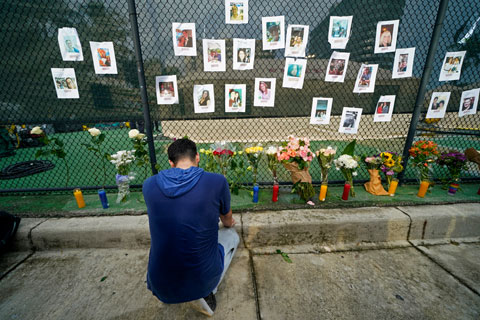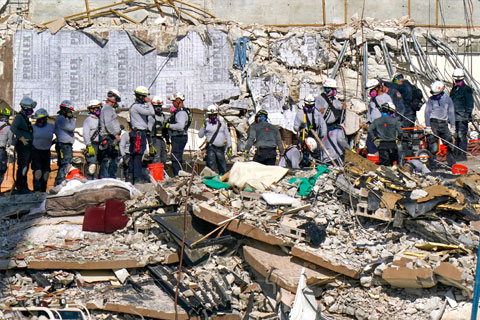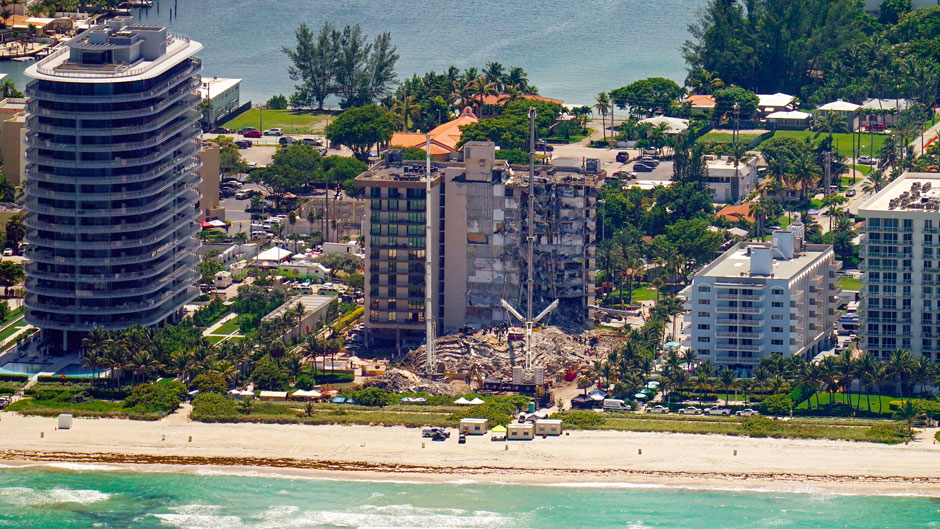The call from the operating room came at 6:24 a.m. Thursday. Trauma surgeon Howard Lieberman was still a bit drowsy when he answered.
“Do you want to reschedule your cases for the day?” the caller on the other end of the line asked. A mass casualty incident had occurred, and Lieberman would probably be needed onsite, he was told.
Lieberman hadn’t heard of any catastrophes. A bit bewildered, he got dressed and drove into work at the University of Miami/Jackson Memorial Medical Center, prepping for a surgical procedure in which he would reconstruct the abdominal wall of a former gunshot victim.
That’s when he got the news: The 12-story Champlain Towers South condominium in Surfside had collapsed in the wee hours of June 24, trapping dozens of residents.

Multiple fire-rescue and law enforcement agencies were already at the scene, and it would just be a matter of time until Lieberman, an assistant professor of surgery in the Division of Trauma and Surgical Critical Care at the Miller School of Medicine, would be deployed to the site as a medical manager of Miami-Dade Fire Rescue’s Urban Search and Rescue Team/Florida Task Force 1, a role in which he has served for nearly three years.
Racing against time, Lieberman performed the scheduled abdominal procedure, then drove north on I-95 headed to Surfside, arriving just after 12 noon to relieve another trauma surgeon who had been on the scene since early morning.
The sight of the pancaked structure evoked memories of 9/11. “It had the same feel, the same look—a building that was there and then suddenly wasn’t,” Lieberman said.
But there was no time to reflect. Lieberman had to spring into action. And he did, tending to the injured and overseeing the medical well-being of Task Force 1 team members who are still navigating the precarious piles of rubble and debris—some with rescue and recovery dogs—in search of survivors.
“We’re still in search-and-rescue mode, hoping against hope that there’s still the viability of pockets, of crevices, where someone could still be there and we can make access toward them,” said Obed Frometa, a lieutenant with Miami-Dade Fire Rescue and a Task Force 1 team member who gathers and packages the vital information and data team members collect as they rotate off the debris field. Frometa refines that data, providing it to the next team that continues the search.
Like Lieberman, he was still asleep when the collapse occurred but was soon deployed after receiving several text messages from team members.

Both Frometa and Lieberman credit the extensive training they and other Task Force 1 team members have received at the University of Miami’s Gordon Center for Simulation and Innovation in Medical Education for helping them to rescue and treat victims of mass casualty incidents such as the collapse of the Champlain Towers South.
Nursing and medical students, physicians, physician assistants, nurses, paramedics, firefighters, and instructors worldwide have all trained at the center, which is renowned for developing educational systems and training curricula that are used globally. A self-learning laboratory, standardized patient training area, a rescue vehicle, a car for extrication of trauma victims, disaster response decontamination showers, and a mock emergency department are just some of the center’s features.
It was the center’s namesake and founder, the late Miller School of Medicine physician Michael S. Gordon, who decades ago designed new training protocols for Miami-Dade first responders to improve and accelerate their response to medical emergencies in the field.
“He realized that what was needed was to take advanced practice interventions and put them in the hands of the first responders on the streets,” said Frometa, a 30-year veteran firefighter/paramedic who is also an instructor at the center.
Advanced Cardiac Life Support, Basic Trauma Life Support, and Emergency Response to Terrorism are just a handful of the courses offered by the center.
Simulation, Lieberman said, is a big part of what the center does. “We can simulate patients in cardiac arrest. We can simulate patients who have problems that require a chest tube placement for traumatic lung injuries,” he explained. “With the equipment and technology we have at the Gordon Center, we can simulate anything that you could imagine.”

More than 18,000 first responders and front-line workers from across Florida train at the center each year, and its training systems have been used at more than 700 institutions in Florida, at more than 2,200 institutions throughout the nation, and in 60 countries, according to S. Barry Issenberg, the Michael S. Gordon Endowed Chair, professor of medicine and medical education, and director of the center.
He calls the center’s 40-year relationship with first responders unique. “There are very few major academic research institutions in the U.S. that have a close and active collaboration with its first-responder community,” Issenberg said. “This extends not only to local and statewide fire-rescue agencies, but also state and community colleges that train paramedics and firefighters. What makes the Gordon Center truly unique is the development of life-saving training curricula that is disseminated to other state and national programs through a train the trainer model.”
The center also collaborates with the U.S. Army Trauma Training Department, partnering with the Ryder Trauma Center to train civilian and military forward surgical teams, noted Angel "Al" Brotons, a long-time firefighter-paramedic who is director of training operations at the center.
With the training received through the Gordon Center, Task Force 1 has also deployed after hurricanes and earthquakes. Last year’s record-breaking Atlantic hurricane season was one of the busiest years, if not the busiest year, of deployment for the team. “All of the deployments seemed to merge into each other,” Frometa said. “There were times when we’d return from being deployed after a storm, removing our equipment from the bus, and it seemed like we’d have to immediately turn around to respond to another crisis. But I’m proud of the team and how it’s able to step into challenging situations and help make a difference in the lives of so many people.”
The condo collapse in Surfside has hit close to home for many of the team members, especially Lieberman.
“This one has been a little bit difficult, because I think a lot of us are separated from the victims by only one or two degrees,” he explained. “A good friend of mine, who I went to medical school with, may have lost three family members. His cousin, his cousin’s wife, and their 1-year-old baby are all missing,” he continued. “I think all of us on this task force are getting messages from people we know saying, ‘Hey, my friend is missing. My loved one is missing. My relative is missing.’ So, that’s been a little bit harder. We know how many people are missing, and we know the clock is ticking. So, that makes it difficult.”
Task Force 1 team members look to each other, and to some of the rescue K-9s at the site, for emotional support while they continue working in a difficult environment.
“There’s devastation, there’s heartache, there’s loss of life, and there are victims that need to be found,” Lieberman said. “But there’s a commonality to all of these [disasters]—that we’re here to save lives.”

